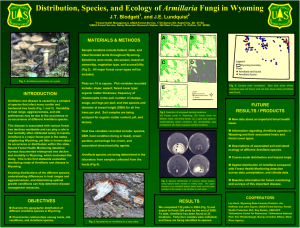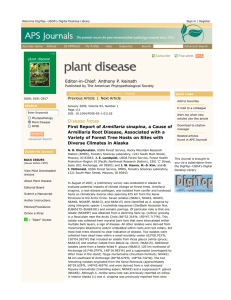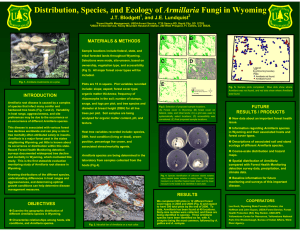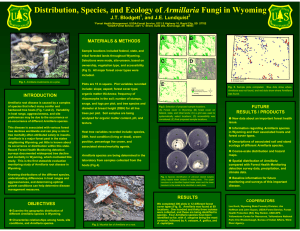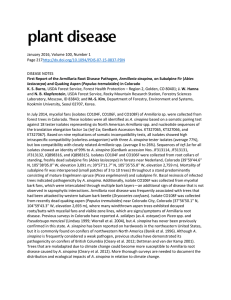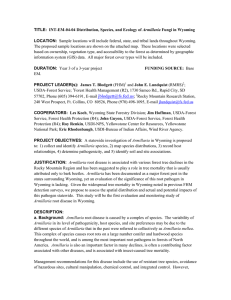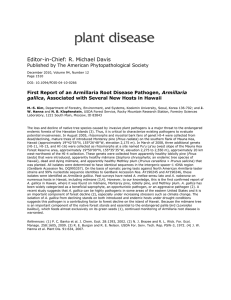T w.
advertisement
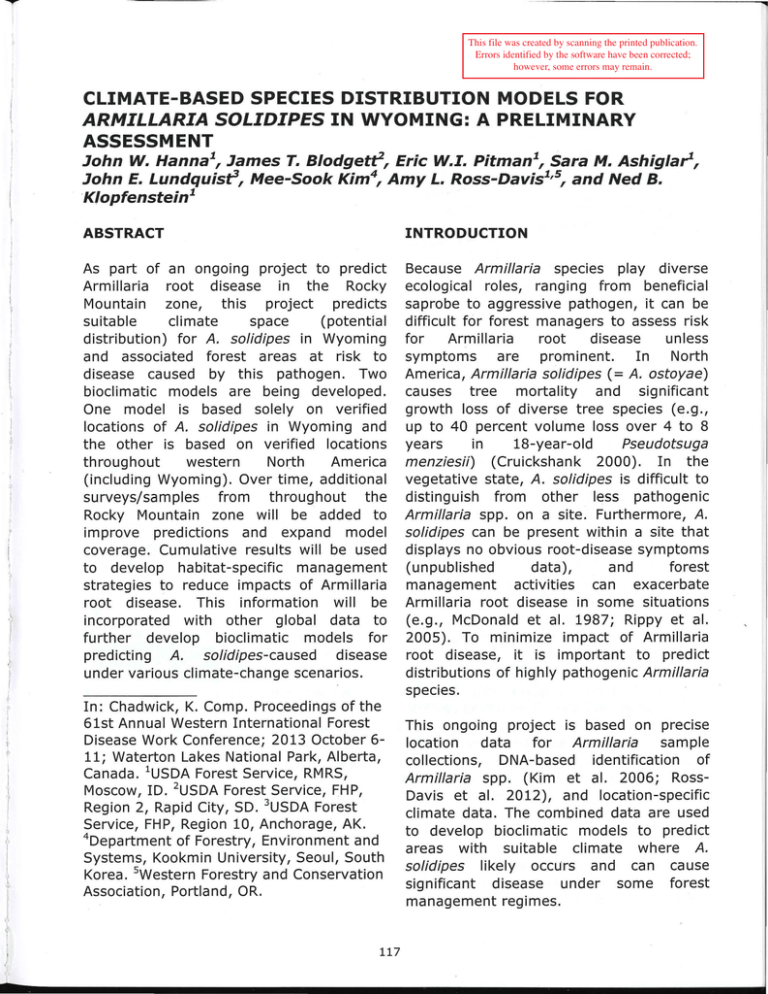
T This file was created by scanning the printed publication. Errors identified by the software have been corrected; however, some errors may remain. CLIMATE-BASED SPECIES DISTRIBUTION MODELS FOR ARMILLARIA SOLIDIPES IN WYOMING: A PRELIMINARY ASSESSMENT .John w. Hanna 1, .James T. Blodgetr, Eric W.I. Pitman 1, Sara M. Ashiglar, .John E. Lundquist3, Mee-Sook Kim 4, Amy L. Ross-Davis 1' 5, and Ned B. Klopfenstein 1 I I ·r ~ ~ t I 1 ( r ABSTRACT INTRODUCTION As part of an ongoing project to predict Armillaria root disease in the Rocky Mountain zone, this project predicts suitable climate space (potential distribution) for A. solidipes in Wyoming and associated forest areas at risk to disease caused by this pathogen. Two bioclimatic models are being developed. One model is based solely on verified locations of A. so/idipes in Wyoming and the other is based on verified locations throughout western North America (including Wyoming). Over time, additional surveys/samples from throughout the Rocky Mountain zone will be added to improve predictions and expand model coverage. Cumulative results will be used to develop habitat-specific management strategies to reduce impacts of Armillaria root disease. This information will be incorporated with other global data to further develop bioclimatic models for predicting A. solidipes-caused disease under various climate-change scenarios. Because Armillaria species play diverse ecological roles, ranging from beneficial saprobe to aggressive pathogen, it can be difficult for forest managers to assess risk for Armillaria root disease unless symptoms are prominent. In North America, Armillaria solidipes ( = A. ostoyae) causes tree mortality and significant growth loss of diverse tree species (e.g., up to 40 percent volume loss over 4 to 8 years in 18-year-old Pseudotsuga menziesii) (Cruickshank 2000). In the vegetative state, A. solidipes is difficult to distinguish from other less pathogenic Armillaria spp. on a site. Furthermore, A. so/idipes can be present within a site that displays no obvious root-disease symptoms (unpublished data), and forest management activities can exacerbate Armillaria root disease in some situations (e.g., McDonald et al. 1987; Rippy et al. 2005). To minimize impact of Armillaria root disease, it is important to predict distributions of highly pathogenic Armillaria species. In: Chadwick, K. Comp. Proceedings of the 61st Annual Western International Forest Disease Work Conference; 2013 October 611; Waterton Lakes National Park, Alberta, Canada. 1 USDA Forest Service, RMRS, Moscow, ID. 2 USDA Forest Service, FHP, Region 2, Rapid City, SD. 3 USDA Forest Service, FHP, Region 10, Anchorage, AK. 4 Department of Forestry, Environment and Systems, Kookmin University, Seoul, South Korea. 5 Western Forestry and Conservation Association, Portland, OR. ), 117 This ongoing project is based on precise location data for Armillaria sample collections, DNA-based identification of Armillaria spp. (Kim et al. 2006; RossDavis et al. 2012), and location-specific climate data. The combined data are used to develop bioclimatic models to predict areas with suitable climate where A. solidipes likely occurs and can cause significant disease under some forest management regimes. OBJECTIVES The objectives of this study are to 1) determine suitable climate space (potential distribution) for A. so/idipes in Wyoming, 2) predict which forest areas are at risk to disease caused by A. so/idipes in Wyoming, 3) develop habitat-specific management strategies to reduce impacts of Armillaria root disease, and 4) incorporate information into a bioclimatic model to predict potential future distribution and disease activity of A. solidipes. METHODS Armillaria isolates were collected in a previous study of the distribution, species, and ecology of Armillaria in Wyoming (Blodgett and Lundquist 2011). From that previous study, 122 Armillaria isolates were recovered from 82 plots, and 61 isolates from 39 plots were determined to be A. so/idipes based on pairing tests against known haploid testers. These 61 isolates were then confirmed as A. so/idipes using DNA-based species identification at the Forestry Science Laboratory, Rocky Mountain Research Station in Moscow, Idaho, USA (Kim et al. 2006; Ross-Davis et al. 2012). The 39 plot locations containing A. solidipes were used in two Maximum Entropy (MaxEnt) species distribution models (Phillips et al. 2006). The first model used only the 39 Wyoming locations (Figure 1) and the second model included the 39 Wyoming locations plus all other confirmed locations for A. solidipes in western North America (Figure 2). Nineteen bioclimatic variables were used in the models (e.g., annual mean temperature, maximum temperature of warmest month, annual precipitation, precipitation of wettest month, precipitation of coldest quarter, etc.). An interpolation grid of ca. 1-km 2 resolution was used, with data derived from 19502000 meteorological records (Hijmans et al. 2005). RESULTS AND FUTURE WORK Two MaxEnt models provided preliminary predictions of suitable climate space for A. solidipes in Wyoming. The first model was based solely on locations of confirmed A. solidipes occurrence in Wyoming (Figure 1) and the second model was based on western North America locations, which included Wyoming (Figure 2). Predictions by these two models were generally congruent, but some differences are apparent. Both models predict wide potential distribution (suitable climate space) of A. so/idipes in Wyoming, especially in coniferous forests. The predictive capacity will be improved by 1) continuing DNA-based identification of Armillaria species from samples collected in root-disease surveys, and 2) adding more locations from diverse geographic areas and climates that are confirmed to contain A. solidipes. This climate window can also be used to examine how various climatechange scenarios (based on projected greenhouse gas emissions, e.g., RCP 4.5 vs. RCP 8.5) may affect distribution and disease activity of A. solidipes. Methods developed from this project can also be used to model other important forest pathogens and examine the potential for invasive species to occupy new areas under climate changes. ACKNOWLEDGEMENTS This project was partially funded by the Forest Health Protection, Special Technology Development Program (R22013-01). 118 MT UT . Figure 1. Confirmed occurrence locations of Armillaria so/idipes ( = A. ostoyae) in Wyoming, based on surveys of Blodgett and Lundquist (2011) (left). Preliminary Maximum Entropy bioclimatic model of suitable climate space (potential distribution) for A. so/idipes in Wyoming based on occurrence points for Wyoming only (Blodgett and Lundquist 2011). Dark green represents predicted suitable climate space for A. solidipes with light green, yellow, orange, and red indicating increased suitability, respectively (right). . . ... f• . ... ' l... . t..:.l-· - .·.. Figure 2. Confirmed occurrence locations of Armillaria solidipes ( = A. ostoyae) in western North America (including Wyoming surveys of Blodgett and Lundquist; 2011) (left). Preliminary Maximum Entropy bioclimatic model of suitable climate space (potential distribution) for A. solidipes in Wyoming based on occurrence points in the western North America (including Wyoming surveys of Blodgett and Lundquist 2011). Dark green represents predicted suitable climate space for A. solidipes with light green, yellow, orange, and red indicating increased suitability, respectively (right). REFERENCES Blodgett, J.T. and J.E. Lundquist. 2011. Distribution, species, and ecology of Armillaria in Wyoming. Pp. 58 in M.L. Fairweather and P. Palacios (comps) Proceedings of the 58th Western International Forest Work Conference, 4-8 October 2010, Valemount, 119 BC, Canada. US Forest Service, Zone Forest Health. Flagstaff, AZ. Cruickshank, M. 2000. Volume loss of Douglas-fir infected with Armillaria ostoyae. Pp. 127-129 in C. Hollstedt et al. (eds) Proceedings, From Science to Management and Back: A Science Forum for Southern Interior Ecosystems of British Columbia. Kamloops, BC, Canada. Hijmans, R.J. and others. 2005. Very high resolution interpolated climate surface for global land areas. International Journal of Climatology 25:1965-1978. Kim, M.-s. and others. 2006. Characterization of North American Armillaria species: Genetic relationships determined by ribosomal DNA sequences and AFLP markers. Forest Pathology 36:145-164. McDonald, G.I., N.E. Martin, and A.E. Harvey. 1987. Armillaria in the northern Rockies: Pathology and host susceptibility on pristine and disturbed sites. Research Note INT-371. USDA Intermountain Research Station. Ogden, UT. Phillips, S.J., R.P. Anderson and R.E. Schapire. 2006. Maximum entropy modeling of species geographic distributions. Ecological Modeling 190:231-259. Rippy, R.C. and others. 2005 . Root diseases in coniferous forests of the Inland West: potential implications of fuels treatments. General Technical Report RMRS-GTR141. USDA Forest Service, Rocky Mountain Research Station. Fort Collins, CO. Ross-Davis, A.L. and others. 2012. Advances toward DNA-based identification and phylogeny of North American Armillaria species using elongation factor-1 alpha gene. Mycoscience 53:161-165. 120
